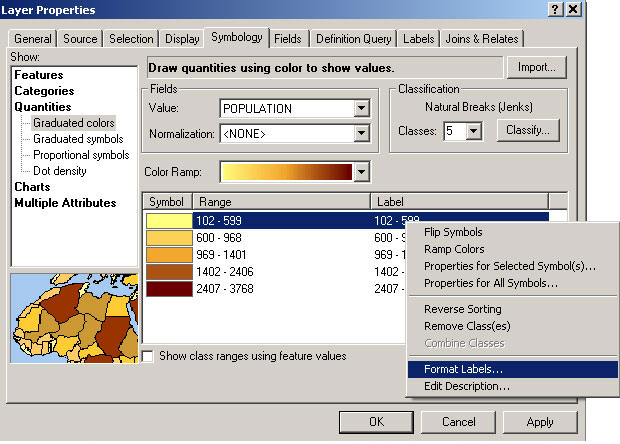
| 11.520: A Workshop on Geographic Information Systems |
| 11.188: Urban Planning and Social Science Laboratory |
[Click here for today's in-class notes. ]
In this exercise, you will build on the basic ArcMap techniques you explored in Lab 1 to make more sophisticated thematic maps. You will make two different kinds of maps: exploratory and explanatory. In the exploratory section, you will compare two thematic maps of the Cambridge population. One map shows population counts by block group and the other normalizes the population counts by dividing by land area to show population density. In the explanatory section, you examine the spatial pattern of home sales prices to see if they appear to be related to housing density. Finally, you will convert some of your finished maps into Portable Document Format (PDF) files, a format that facilitates electronic distribution of your work.
Step 1. Attach 11.520 Locker. This is exactly the same step as in Lab1.
Much of our class data reside in the course locker, 11.520. This locker is accessible via the Andrew File System (AFS) as Z:\afs\athena.mit.edu\course\11\11.520. However, ArcMAP can have trouble trying to read upper-level directories on AFS drives. (ArcMAP insists on trying to find mapable data in each sub-directory that it examines. The upper-level directories on AFS are spready among machines around the world and ArcMAP will spend forever looking.) Since we will use the class locker repeatedly, we might as well map the locker to a 'virtual' local drive and avoid this problem. To map the class locker to your M:\ driver, open a DOS command window, click Start and choose "Run.... "
In the DOS command window, type: "attach -Dm 11.520" and press enter. This will mount //afs/athena.mit.edu/course/11/11.520/ to drive M:\ for access to the class locker 11.520. Later we will add data from this locker.
Step 2. Start ArcMap by follow the following steps.
1. Click the Start button in the left bottom corner.
2. Move the mouse over the item Programs.
3. Move the mouse over the item ArcGIS
4. Move the mouse over the item ArcMap and Click.
Please wait patiently for ArcMap to launch. The program takes awhile to come up.
As in Lab 1, we will use 1990 U.S. Census data for Cambridge for this exercise. In ArcMap, add cambbgrp (the Cambridge Block Group shapefile in the M:\data directory). Open the Data Frame Properties (View > Data Frame Properties from the menu bar) window and set the "Map Units" to meters and the "Display Units" to feet.
Use the Layer Properties window to change the name of this theme to Population. To change the number of decimal places, put the cursor on a label, click right mouse butten. It will open a Number Format window. Since numbers represent population, choose numeric and set the number of decimal places you want. In this case, set 1 for number of decimal degree.
 |
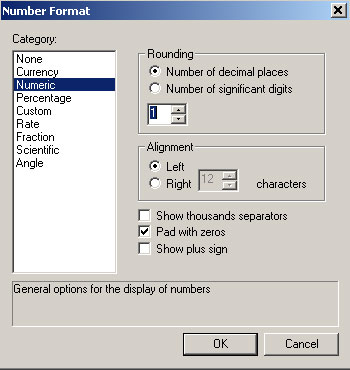 |
You have created an unnormalized map of Cambridge population by block group. Your map isn't as meaningful as you might like since your thematic shading depends only on the raw number of people in each block group - regardless of whether a block group is itself large or small. In such cases where your raw data are not 'normalized' (i.e., adjusted to represent a compared-to-something-meaningful comparison), it is easy to generate a pretty looking map that is quite misleading. Shortly, we'll compare this thematic map with one that does normalize the population count. But, first, lets spruce up the map a bit.
Click on the Add layer button ![]() , and add majmhda1.shp from M:\data
. This is a MassGIS (Massachusetts Geographic Information Systems) Major
Roads Datalayer created in December 2000.
, and add majmhda1.shp from M:\data
. This is a MassGIS (Massachusetts Geographic Information Systems) Major
Roads Datalayer created in December 2000.
Now let's adjust the characteristics of the major roads theme. First, change
the name of the layer to Major Roads. Next, open the Layer
Properties window and click the symbology tab and set
the properties as follows:
By default, ArcMap does not choose a very attractive symbolization scheme for the roads. You will need to adjust the symbols manually. Set the symbols as described in Table 1.
| Value | Color | Size | Style |
|
|
Red |
|
Solid |
|
|
Blue |
|
Solid |
| 3 | Dark Gray |
|
Solid |
|
|
Dark Gray |
|
Dotted |
When you're done, your layer properties-symbology window should resemble Fig. 7. Note that the full text of the labels is cut off in Fig. 7; you should enter the full text of the description as documented in the dataset's metadata. Don't forget to apply your changes!
Now you will create a normalized map of the population data. Normalizing means adjusting for effects that distort the way the data appears. Here, you will compensate for the effect of land area on population. Larger areas typically have larger populations than smaller ones, but the actual densities of the areas may be quite different.
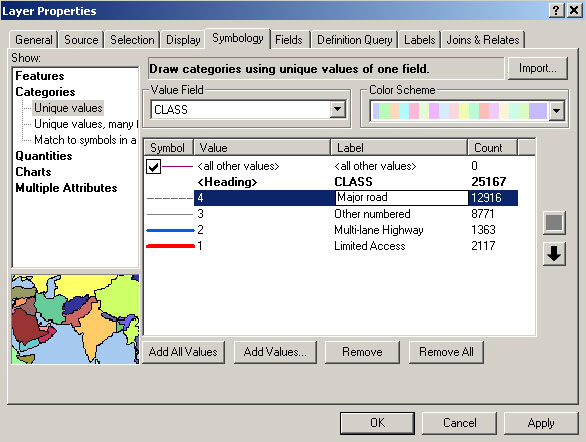 |
Create a new data frame by select insert "Data Frame" menu from the
menu bar. You should now see the "New Data Frame" icon
in the data frame window. Select the Major Roads layer under "Layers",
click the right mouse button and select "copy". Then select the "New
Data Frame", click the right mouse button and select "Paste Layer". Now
paste the Population layer into the "New Data Frame".
Remember to set the Map and Display units for this new data frame.
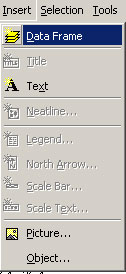 |
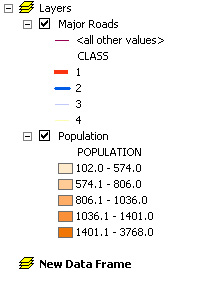 |
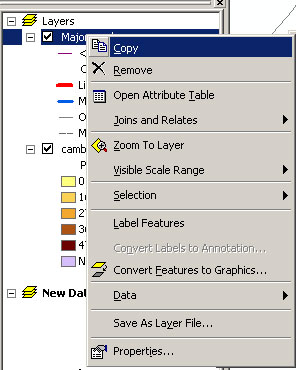 |
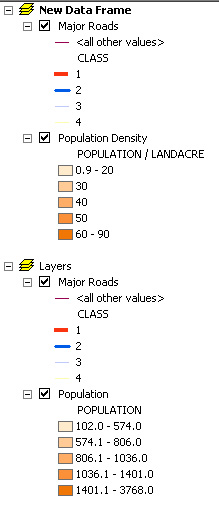 |
| Insert a New Frame | New data frame appears | Copy layers from existing frame | Paste layers to the new frame |
Open the layer properties to modify the Population layer. Adjust the number of decimal places to "1" and set the "Normalize by:" field to "Landacre." In ArcMap, the 'normalize by' option is used to pick an attribute that will be divided into the mapped attribute before doing the classification and shading. Hence, normalizing by landacre will create a population per acre measure. You should still be using the "Quantile" classification with 5 classes and "Orange Monochrome" color ramps. When you apply your changes, you will have a population density map. Change the layer's name to Population Density. Mathematically speaking, what did the setting the normalization field do to the population values? Is the population density map more consistent with your impression of the parts of Cambridge that are more crowded? Also, compare the result when you normalize by the 'Area' attribute rather than the 'Landacre' attribute. The 'Area' attribute is the area (in square meters) of each block group polygon whereas the 'landacre' measure excludes bodies of water (like the Charles River Basin or Fresh Pond).
Since you have two data frame and data view displays only one frame at a time, you need to activate a frame to see it. For example, if you want to see "New Data Frame", click right mouse button with the mouse over "New Data Frame", and then select "Activate". (Note, you *can* show two maps within one "layout" view. We will cover that soon.)
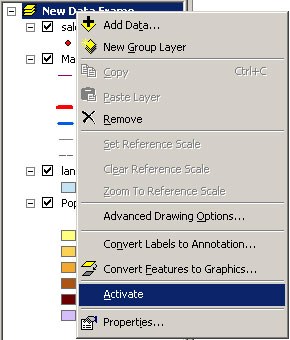 |
You should be able to spot one or more areas in your two maps of
Cambridge where the discrepancy between the two maps is especially apparent. In
the original "Layers" frame (the unnormalized map), highlight one of these areas by
drawing a circle around the area with the New Circle tool ![]() . To select the New Circle tool, you will first need to
open the draw tool pop up menu as shown in table 2 and select the New
Circle from the pop up list of icons that appears. The complete list of
drawing tools is shown in Table 2.
. To select the New Circle tool, you will first need to
open the draw tool pop up menu as shown in table 2 and select the New
Circle from the pop up list of icons that appears. The complete list of
drawing tools is shown in Table 2.
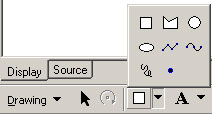 |
 |
New Marker
New Line New Curve New Rectangle New Circle New Polygon New Ellipse New Freehand |
 to add
some text annotation near the circle explaining why you put it there (e.g., "Zone
of High Discrepancy"). Use only a few words and choose font characteristics that
will make the text visible but not overwhelming. Note that, as with the drawing tools,
you can choose an annotation style from a pop up list. You can experiment with these
if you wish.
to add
some text annotation near the circle explaining why you put it there (e.g., "Zone
of High Discrepancy"). Use only a few words and choose font characteristics that
will make the text visible but not overwhelming. Note that, as with the drawing tools,
you can choose an annotation style from a pop up list. You can experiment with these
if you wish.Labelling features on the map can help viewers orient themselves. Labelling
too many features, however, clutters up the map and impedes readability. Let's
put identifying markers on stretches of limited access highways, symbolized
by thick red lines on your map. Use the "i" Info tool ![]() to look at the attributes of the highways. Make sure that the Major
Roads layer is selected first. You will probably find that at least
two records show up for each click; that's because the two directions of the
multilane highways have been encoded separately, as if they were two different
routes very close to one another. If you watch closely as ArcMap flashes the
matching links, you can actually see this.
to look at the attributes of the highways. Make sure that the Major
Roads layer is selected first. You will probably find that at least
two records show up for each click; that's because the two directions of the
multilane highways have been encoded separately, as if they were two different
routes very close to one another. If you watch closely as ArcMap flashes the
matching links, you can actually see this.
Interstate 90 (a.k.a. the Mass. Pike) extends east-west near the bottom of the image. As you identify links along this stretch, you should see that the "Rt-number" field is "90" and that the "Admin_type" is "1." From the metadata, you can see that an Admin_type of 1 indicates an Interstate highway. We want to label a few roads using their "Rt-number" field. Open the Layer Properties window for this theme. Click on the "Labels" icon and confirm that the "Label Field" is set to "Rt-number."
ArcMap has some nice cartographic goodies that will let us put highway shields
on the maps not unlike those you've seen in commercial road maps. Go to Menu
View/Toolbars, select labeling tool box. The labling tools like fig 10. will
appear in ArcGIS software. Click the second button ![]() to bring up lable manager dialog and input 90 as a new class name and click
add (seee table 3-1). A new class with name "90" will appear on the
left side. Right click "90" to select it, and select SQL Query to
select I-90 from the roads (see table 3-2). In the sql query input window, input
as shown in table 3-3, and click ok. Next, click the "Symbol" button
to bring up lable manager dialog and input 90 as a new class name and click
add (seee table 3-1). A new class with name "90" will appear on the
left side. Right click "90" to select it, and select SQL Query to
select I-90 from the roads (see table 3-2). In the sql query input window, input
as shown in table 3-3, and click ok. Next, click the "Symbol" button
![]() , then select the "U.S. Interstate
HWY" sheild among many label styles (see table 3-4). Now click Apply
to see the the shield to appear on I-90, and click OK to exit
the labling tool box.
, then select the "U.S. Interstate
HWY" sheild among many label styles (see table 3-4). Now click Apply
to see the the shield to appear on I-90, and click OK to exit
the labling tool box.
 |
|
Fig 10.
Labeling Tool Bar |
|
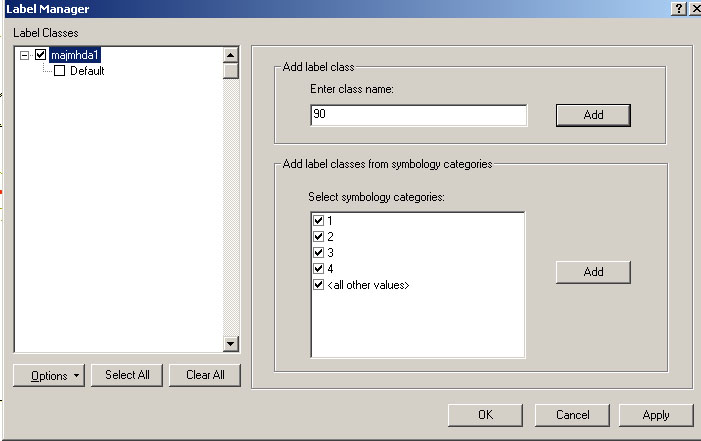 |
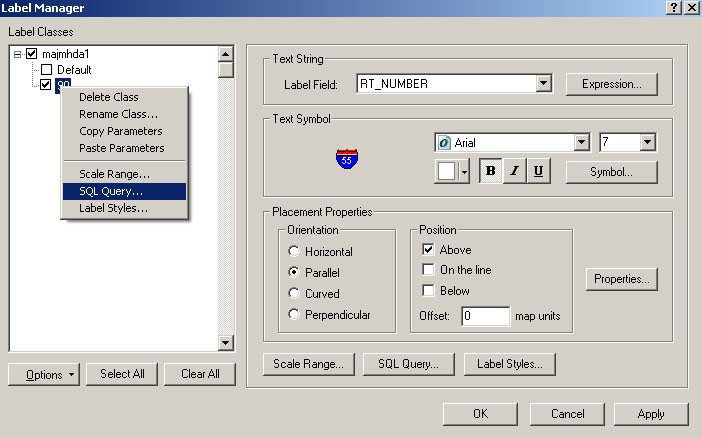 |
Table 3-1. add a new class |
Table 3-2. make a query to select I-90. |
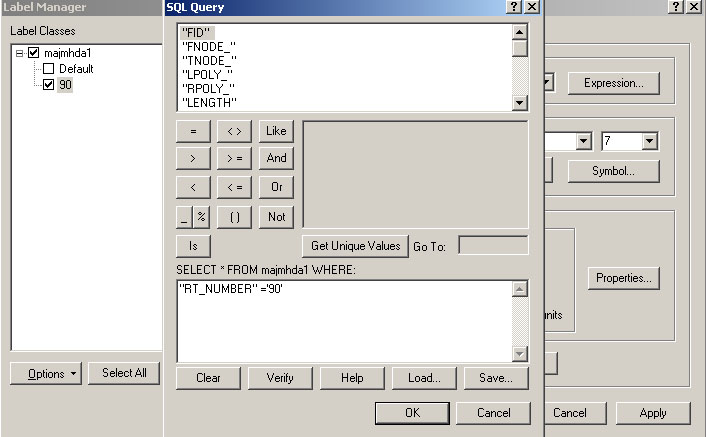 |
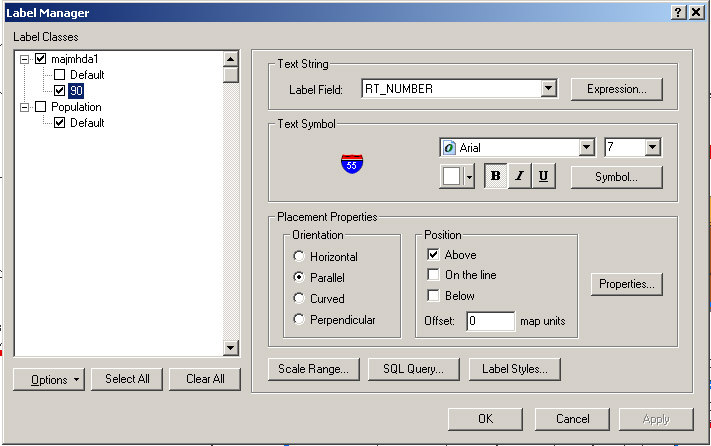 |
Table 3-3. the sql query |
Table 3-4. select the symbol for I-90 |
Other limited access highways visible in this view are Interstate 93, Mass. State Route 2, and a tiny stub of US 1. Place labels on I-93 and Mass. 2 and ignore US 1. Note that Mass. 2 should not get an Interstate shield since it is a state highway (Admin_type = 3); instead use a round, square, or oval shield. The full set of label tools is shown in Table 3. ArcMap gives you some control over the fonts and colors that appear in the shield symbols. To alter the settings, you may open the Layer Properties window, select the Labels tab and click the Symbol button to open the Symbol Selector window, which gives you the chance to alter the settings. You can experiment with this if you wish, but it is not necessary for this exercise.
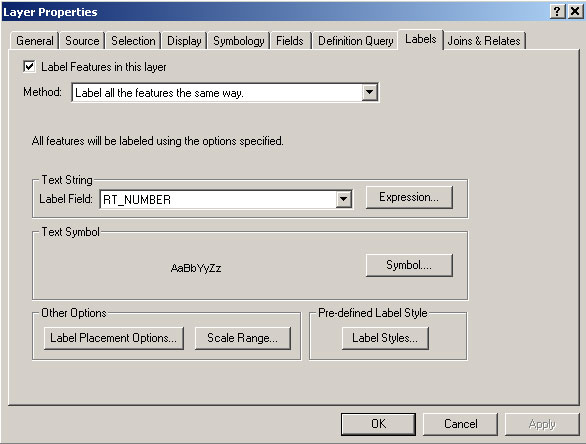 |
In this layout we want the two view frames to be the same size and
lined up vertically, with "Layer" frame higher on the page than "New
Data Frame." Fortunately, ArcMap has tools to resize and align layout
elements. Select the Arrow Pointer tool ![]() .
Move "View1" near the top of the page and "View2" near the bottom,
resizing them, if necessary, so that they both fit. You may also need
to move the other layout elements. Now, hold down the Shift
key, and click on both frames to select them. Click the right mouse
button and choose Align Center from the Align
menu.
.
Move "View1" near the top of the page and "View2" near the bottom,
resizing them, if necessary, so that they both fit. You may also need
to move the other layout elements. Now, hold down the Shift
key, and click on both frames to select them. Click the right mouse
button and choose Align Center from the Align
menu.
 |
Now let's spiff up the frames by adding a border line around their edges. Select one of the view frames and click the right mouse button. Choose properties from the bottom of the drop down menu list. Properties window will come up. Select Frame tab then set the characteristics of border lines as you wish (we recommend keep default settings for this lab.) and click OK. You should see a black line forming a tight box around the view frame. Repeat this procedure for the other view frame.
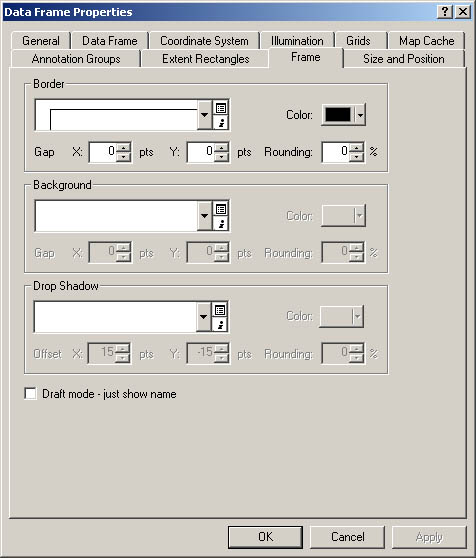 |
Next, you need a legend, a scale bar, and a north arrow to improve the
layout view of the map. First, let's insert a legend for the "Layers" frame,
Activate the view frame either by clicking it or click the name of data
frame(Layers) and then click the right mouse button, and select "activate" from
the drop down list. Now select the Insert
menu from the menu bar, and select legend.
The Legend Wizard window will come up. Using the legend wizard, you can
choose which layers will be shown in the legend. For this exercise,
select all the names of layers shown in Map Layers
space and click ">" button. Selected layers will
be shown in the Legend Items space. Click Next.
Change the legend title, set font, color and click Next.
Now you can choose border line characteristics. Click Next
and set spacing between the parts of your legend and click Finish.
The legend will show up on the layout view. Follow the same steps,
create legend for "New Data Frame". Also, insert scale bars and north
arrow for both view frames.
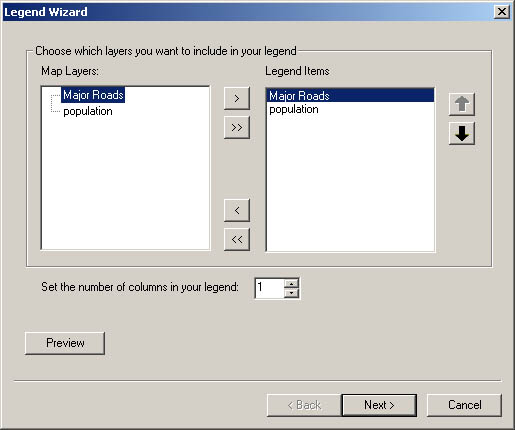 |
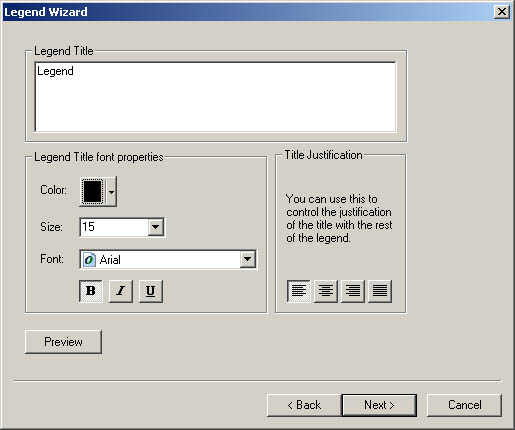 |
| Fig. 14. Select Legend Items | Fig. 15. Set legend title |
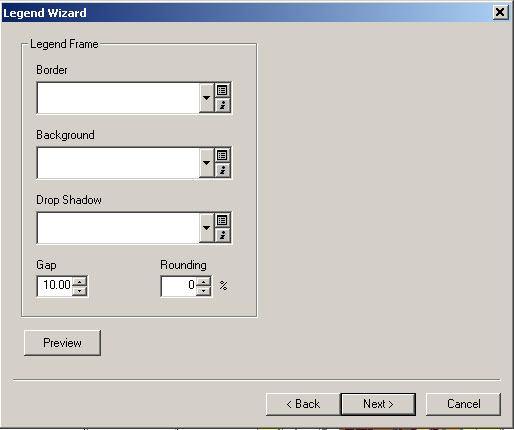 |
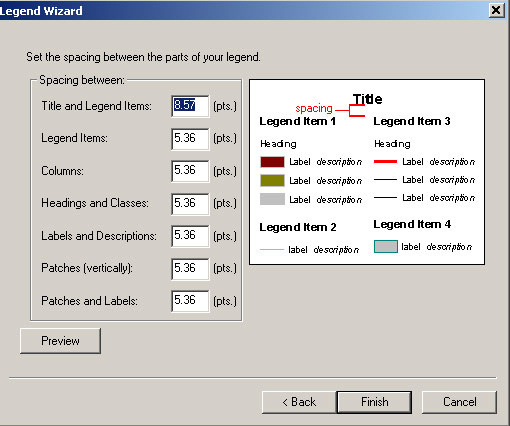 |
| Fig. 16. Set Border Line | Fig. 17. Set Spacing between Parts |
Finally, round off your map by setting the title of the layout to "Population of Cambridge, MA, 1990" and adding your name, today's date, and appropriate credit to the data source. When you're happy with the way that it looks, save your project, and print out your map.
Open the table for Landuse85.shp (click once on the layer to activate it and click right mouse button and select Open Attribute Table).. The field called "Landuse" is the only one we're interested in.
Fortunately for you, a legend was previously prepared for this layer using ArcView. Click the Import button, navigate to the usual M:\data directory and select the file landuse.avl (the avl stands for ArcView legend). Click OK. Your layer should pick up the saved symbolization choices. By default, ArcMap orders the categories (values) alphabetically, but we would rather group the residential categories together and have them at the top of the legend. Moving the categories helps us understand them better and will "read" much better on our final map. To move categories, simply click on a symbol and click the up and down arrow buttons in the right side of the window. Locate it where you would like it to be. Move the residential categories to the top:
Open the layer properties for Sales89_shape. Using "Realprice" as your "Classification Field," try out the "Legend Types" "Graduated Color" and "Graduated Symbol." Also try the classification schemes "natural breaks," "quantile," and "equal interval." Remember the question we were interested in? Have these exploratory symbolization exercises shown you the relationship between sale price and land use? It's very difficult to see any type of pattern with so many data points, especially in a place like Cambridge, where high and low income neighborhoods are so close together. We'll now abandon the automatic classification settings and use some of our expertise to determine the classes. We'll look only at very high-priced properties and very low-priced properties. Change the number of classes to "3" in the layer properties - Symbology tab and click Classify button. Change the first number shown in "Break Values" from something like 490196 to 100000 and second number to 1000000. Now you have three categories, less than 100000, more than 1000000, and in between. Click O.K. and Change the color and size of second category (realprice from 100000 to 1000000), so that two extreme values, lower than 100000 and higher than 1000000, stand out. Give the points bright colors that will show up on top of the land use layer. Notice that the high-priced properties are in the lowest density areas. We're on our way to making an explanatory map!
We do not have time to cover all of the symbolization possibilities in ArcMap. The built-in ArcMap help has some useful examples of thematic maps. To see them, select Help Topics from the Help menu. The Help system can take some time to launch. When the ArcMap Help window appears, click once on the "Contents" tab, double-click on the "Creating and Using Maps" book icon, double-click on the "Choosing colors and symbols" book icon, and double-click on "Types of thematic maps."
As an added refinement, add a "picture frame" to your layout that includes a CRN and a MIT logo. You will need to use Insert > Picture menu to insert following JPEG files in M:\data:
Make sure to save your map document file before continuing with the next part of this exercise.
PDF format: This is a format we will use often. Files in this format can be read using a free program called Acrobat Reader. This program comes in a standalone version and as a web browser plugin. The benefit of this format over a JPEG and other bitmap formats is that it's resolution independent. You can zoom in and out of the map and print it at any scale. To create a PDF file from your layout in ArcMap, select File > Export Map. Exoprt window will show up. From the Export window, select the file location, choose "PDF(*.pdf)" option for Save as type, type the File name you want, then click Export.
JPEG format: Follow the same step describe above and choose "JPEG(*.jpg)" as Save as type. Unfortunately, JPEG use "lossy" compression, meaning that a JPEG image is not fully faithful to the original. Artifacts caused by the lossy compression are often visible in JPEG versions of maps. Also, like any bitmap format, JPEGs have a fixed resolution, limiting the ability to zoom in effectively. JPEGs are useful for overview graphics on web pages, while PDFs can be used to supply the full detail.
1. Create an exploratory map as described in II A and print it out in Black and White.
2. Create an explanatory map as described in II B and print it out in Color (There is a color printer "Echo" in room 37-312).
Note: All the maps you produce should contain your name, a title, legend, north arrow, scale bar, data source attribution, and, for the Question 2 map, a CRON and MIT logo.
3. Export the two above maps into .pdf format and make it available online.
Since you are at MIT, it's pretty easy publishing your work on the web. As you can see in the explorer, you already have a folder named "www" under I:\ drive. If you save anything in your public "www" folder, then it is automatically up on the web. Now for this class, create a new folder named "11.520" under your I:\www folder. Then save your pdf files in that folder. You don't have to create a good web page for this. Just copy and paste your pdf files into the 11.520 folder you just created. For those who are not MIT students and do not have web spaces, please email pdf files to 11.520staff@mit.edu
Lab 2 is due by the beginning of the class on Sep. 24th, 2008. Hand in your printouts (two maps) to an instructor and send the URL of the two .pdf files to 11.520staff@mit.edu
Created by Thomas H. Grayson.
Includes significant portions originally written by Raj
Singh.
Modified for Fall 2000-08 by Thomas H. Grayson, Myounggu Kang, Jeeseong
Chung, Jinhua
Zhao, Xiongjiu Liao, Mi Diao. Yang Chen. and Yi Zhu.
Last Modified 14 Sept.. 2008 by Joe Ferreira.
Back to the 11.520
Home
Page.
Back to the CRON
Home
Page.
Please send comments about this page to the 11.520 class staff <11.520staff@mit.edu>.